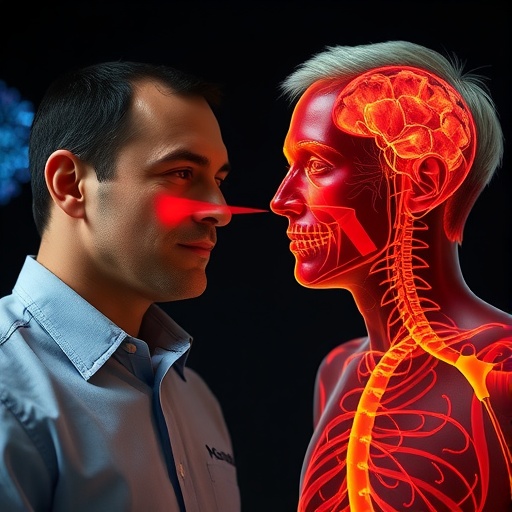In the relentless quest to unravel the mysteries of neurodegenerative diseases, a groundbreaking study published in Nature Communications has illuminated a promising new pathway for detecting Lewy body pathology, a hallmark of debilitating disorders such as Parkinson’s disease and dementia with Lewy bodies. This pioneering research employs a sophisticated two-step diagnostic approach that combines non-invasive olfactory testing with cutting-edge cerebrospinal fluid (CSF) analysis, offering unprecedented precision in identifying early pathological changes that have long eluded clinicians.
Lewy body pathology, characterized by the abnormal aggregation of a protein called α-synuclein within neuronal cells, underpins a spectrum of neurodegenerative illnesses whose diagnosis typically hinges on clinical symptomatology and post-mortem confirmation. For decades, the field has grappled with the challenge of detecting these protein aggregates in living patients. The advancement featured in this latest study represents a paradigm shift, leveraging the subtle yet clinically significant dysfunction in the sense of smell—a common early symptom seen in individuals harboring Lewy body pathology—as a sentinel biomarker.
At the heart of this two-step protocol lies the initial screening through olfactory function tests. Anosmia, or loss of smell, often predates the motor and cognitive manifestations of synucleinopathies by years. By employing standardized smell identification assays, researchers can stratify patients who exhibit marked olfactory deficits, thereby enriching the pool of individuals likely to harbor underlying α-synuclein pathology. This non-invasive, cost-effective, and easily deployable test lays the groundwork for the subsequent confirmatory step.
Once individuals with pronounced smell dysfunction are identified, the next phase harnesses the power of seed amplification assays (SAA) performed on cerebrospinal fluid samples. These assays detect minute quantities of misfolded α-synuclein seeds capable of propagating pathological aggregation in a prion-like manner. The remarkable sensitivity and specificity of α-synuclein SAA transform cerebrospinal fluid into a veritable window into the molecular underpinnings of neurodegeneration, surpassing prior diagnostic modalities that struggled with ambiguous biomarkers.
The intricate biochemical mechanics of α-synuclein seed amplification rest upon the ability of pathological seeds to induce the conversion of normal α-synuclein molecules into aggregated fibrillar forms under laboratory conditions. This amplification mimics the pathogenic cascade occurring in vivo, thus magnifying the signal to detectable levels within the CSF. Such sensitivity ensures that even early-stage pathology, invisible to traditional imaging and clinical assessment, becomes accessible to diagnosis.
Crucially, the study outlines the synergistic value of combining olfactory testing with CSF SAA, demonstrating that initial smell-function screening enriches the candidate pool with a high likelihood of pathology, thereby optimizing the utilization of the more invasive CSF assay. This strategic sequencing not only enhances diagnostic accuracy but also minimizes unnecessary lumbar punctures, preserving patient comfort and resource allocation.
Moreover, the implications of this dual-step diagnostic method extend beyond improved detection. Early and accurate identification of Lewy body pathology can profoundly influence patient management, opening avenues for timely therapeutic interventions, enrollment in clinical trials, and personalized care strategies. By pinpointing pathology earlier, clinicians can tailor treatments to mitigate progression and improve quality of life.
This research also challenges prior dogma that regarded olfactory dysfunction merely as a clinical symptom rather than a biomarker with tangible diagnostic potential. The quantitative approach to smell function testing adopted here transcends subjective evaluations, incorporating precise olfactometric measurements that correspond robustly with CSF biomarker findings.
In addition, the molecular precision afforded by α-synuclein seed amplification could redefine diagnostic criteria for synucleinopathies, moving the field towards objective, biomarker-driven classifications. This shift has broad ramifications for research and clinical practice, fostering consistency in patient categorization and facilitating longitudinal monitoring of disease evolution.
While the study heralds a new era in neurodegenerative diagnostics, it also acknowledges inherent limitations. The invasiveness of CSF collection remains a challenge, underscoring the need for future refinement, potentially involving peripheral biofluids or imaging correlates. Furthermore, large-scale validation across diverse populations is necessary to ensure generalizability and to calibrate diagnostic thresholds accurately.
Nevertheless, the integration of smell testing and α-synuclein seed amplification sets a compelling precedent. It exemplifies how converging insights from sensory neuroscience and molecular pathology can collectively surmount longstanding obstacles in disease detection. This confluence of methodologies resonates deeply with the broader movement towards precision medicine, emphasizing personalized diagnostics anchored in molecular biology.
Experts in the field have hailed this advancement as a critical milestone that bridges clinical presentation and neuropathology through accessible, quantifiable metrics. It paves the way for more nuanced understanding of the heterogeneity inherent in synucleinopathies, accommodating variability in symptom onset, progression, and response to therapy.
Looking ahead, the practical implementation of this two-step approach could reshape screening protocols in neurology clinics worldwide, enabling the identification of at-risk individuals even before motor symptoms emerge. This pre-symptomatic detection capability has profound implications for patient counseling, lifestyle interventions, and pharmacological development.
Moreover, the technological underpinnings of α-synuclein seed amplification may inspire analogous assays targeting other pathological proteins implicated in neurodegeneration, such as tau or beta-amyloid, thereby broadening the impact of this methodological leap across related disorders.
In essence, this research epitomizes the transformative potential of combining sensory testing with molecular diagnostics. It opens a new window into the silent prodromal phase of Lewy body diseases, where intervention may yield the greatest benefit. The path forward will undoubtedly involve refining these techniques and integrating them into multi-modal diagnostic frameworks that harness imaging, genetics, and fluid biomarkers in concert.
Ultimately, the vision forged here beckons a future where neurodegenerative diseases are unmasked with unprecedented clarity, allowing clinicians to tailor interventions with surgical precision and patients to navigate their journeys armed with knowledge and hope.
Subject of Research: Detection of Lewy body pathology using combined olfactory function testing and cerebrospinal fluid α-synuclein seed amplification assays.
Article Title: Two-step detection of Lewy body pathology via smell-function testing and CSF α-synuclein seed amplification.
Article References:
Mastenbroek, S.E., Collij, L.E., Vogel, J.W. et al. Two-step detection of Lewy body pathology via smell-function testing and CSF α-synuclein seed amplification. Nat Commun 16, 7182 (2025). https://doi.org/10.1038/s41467-025-62458-7
Image Credits: AI Generated




